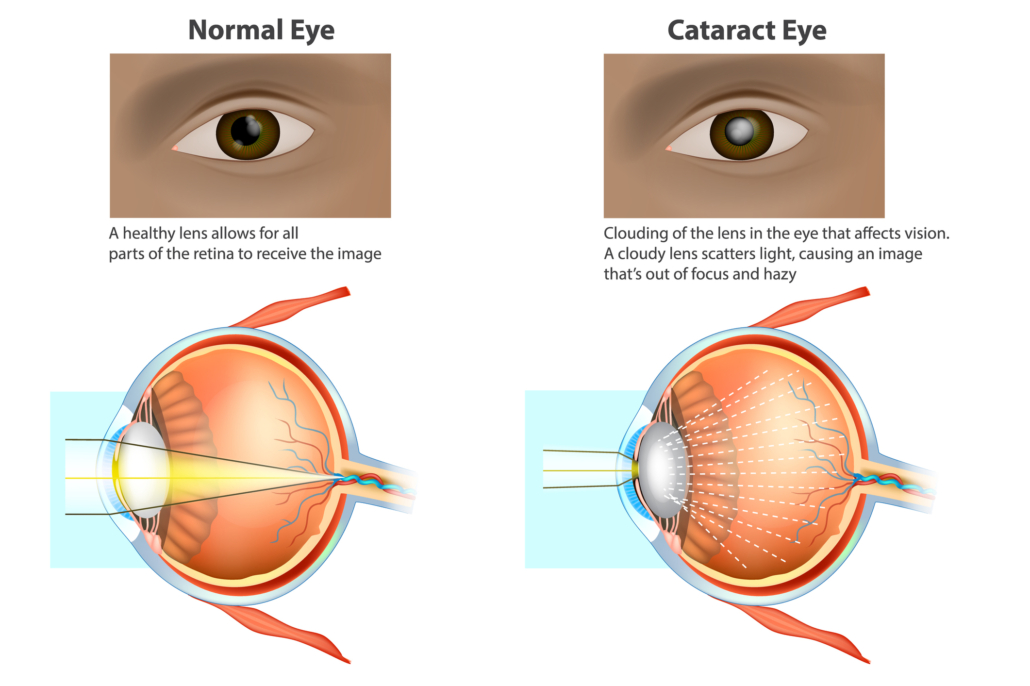Symptoms
- Dull/ Distorted/ blurry/ hazy vision
- Yellow discolouration
- Poor night vision
- Colour desaturation / Faded colours
- Increased sensitivity to glare
- Halos surrounding lights
- A need for frequent changes in prescription glasses
Causes
The most common cause of Cataract is ageing (typically above the age of 50), which causes changes in the lens of the eye. Other causes are:
- genetics: having parents, brothers, sisters, or other family members who have cataracts
- Diabetes
- Smoking
- Injury
- radiation treatments on the upper body
- Exposure to ultraviolet (UV) rays
- Drug induced: Certain medications such as Steroids/ other prescription drugs may cause early formation of cataract
Treatment
The ONLY way to cure a cataract is through surgery. There are no medicines, eye drops, exercises or glasses that can help to remove cataract.
Phacoemulsification or Micro Incision Cataract Surgery (MICS) is the most common and popular treatment for cataract. The surgery leads to improved vision and eliminates the chances of getting blind.
MICS advantages:
- Stitchless
- Bloodless
- Painless
- High precision by skilled and experienced surgeons
- Minimal incision (around 2mm)
- No unnecessary financial burden to patient
- Quick healing and post-operative recovery
- Day care / Walk-in walk out procedure
- Minimum precautions post surgery
- Foldable intraocular lens (IOL)
Procedure
- Patient is advised to have a light breakfast prior to the surgery.
- The surgery involves removal of the opacified natural lens
- The cataract is emulsified and removed using an ultrasonic phacoemulsification probe
- The opacified natural lens is replaced with an artificial and clear foldable intraocular lens (IOL)
- The replaced lens is permanently and remains inside the eye for life.
Types of Intraocular Lenses (IOLs)
| Types of IOL | Monofocal IOL | Toric IOL | Multifocal IOL | Extended Depth of Focus (EDoF) |
|---|---|---|---|---|
| Pros | Good vision for distance.
Better contrast and colour especially in dim light conditions, Less glare No halos | For correcting significant cylindrical power.
Sharper Distance vision without glasses. | Good vision for distance and near without glasses. | Latest Multifocal IOLs.
Good vision for distance, computer distance and near without glasses. Lesser chances of glare and halos at night. Better contrast. |
| Cons | You will have to wear glasses for near work (reading and computers). | You will have to wear glasses for near work (reading and computers). | For very fine print, reading glasses may still be needed.
Problem of glare and halos may occur at night. | For near vision, reading glasses may be needed. |
Choosing your IOL
Your doctor is the best person to discuss and advise the lens which is most suited for the patient.
Post operative precautions
There are no major precautions required post surgery, however the patient is advised the following 3 PRECAUTIONS FOR 3 WEEKS:
- No splashing of water directly into the operated eye
- No rubbing of the operated eye
- No lifting of heavy weights
FAQs
How is a cataract detected?
A thorough eye examination by your ophthalmologist can detect the presence of a cataract.
How fast does a cataract develop?
This varies from individual to individual, and may even differ between the two eyes.
How can a cataract be treated?
Cataracts cannot be treated with medicines, eye drops, exercises or glasses, surgery is the only way to remove a cataract.
When should surgery be done?
Surgery is required when the cataract causes loss of vision such that it starts to interfere with a person’s daily activities. They don’t need to be removed just because they are present.
What is phacoemulsification cataract surgery?
Phacoemulsification is a non-stich method of cataract removal by ultrasonic fragmentation and aspiration of the cataractous lens through a small wound. It gives better intraoperative control and faster postoperative recovery. With this surgery, patients can resume their daily activities sooner and with fewer restrictions than traditional cataract surgery.
Are there any complications associated with phacoemulsification surgery?
Phacoemulsification surgery is an easy and safe procedure thanks to advanced technology. As is the case with all surgeries, there are some complications that can happen after phacoemulsification surgery too. There could be a fluid discharge after the surgery, which can be treated with medication.
What is the probability of getting a cataract again after phacoemulsification surgery?
There is almost no chance of getting a cataract again after phaco surgery. However patients are advised to take good care for a few days after the surgery.
What is the guarantee of getting clear vision after this surgery?
In almost all cases phacoemulsification surgery leads to improved vision. Right after surgery usually there is blurred vision, which gradually improves as the eye heals, with correct medication.
Is there any chance of wearing glasses again after phacoemulsification surgery?
Most people don’t require glasses after this surgery, but in some cases they may be required after this treatment.
What are premium intraocular lenses?
Tonc IOL’s, Multifocal IOL’s. Trifocal IOL’s are various premium intraocular lenses which help in eliminating the need for glasses following cataract surgery.

